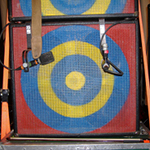Wade Guyton
Wade Guyton OS
Whitney Museum of American Art
945 Madison Avenue, New York, NY
October 4, 2012–January 13, 2013
Walking through “Wade Guyton OS,” I can’t help but think of Wire’s postpunk anthem “12XU,” a blistering two-minute blast of abrasive fury that concludes the British band’s 1977 debut album Pink Flag. While admittedly literal, iconographic similarities between a single song and Guyton’s inkjet prints on linen are nevertheless striking. The artist’s terse repertoire of imagery includes the letters X and U, and he folds the canvas on which he positions them in half before feeding one side into an inkjet printer, then flipping it over to run through again. Wire’s accelerated, monotonous rhythm—“trimmed to a concise chukka chukka chukka,” according to Wilson Neate in his 33 1/3 book on the record—is not unlike the steady mechanical tempo of Guyton’s Epson 9600, or visually, the flickering rhythm of a 2008 collection of eight canvases (most works in the exhibition are untitled) placed side by side, each with two alternating sections of thick black and white stripes, derived from the same digital file.
Guyton’s tools are a computer, image scanner, and inkjet printer, but his results contrast with normative uses of consumer-grade digital technology, similar to how deskilled punk musicians approached their instruments, or to the Xerox-based printed matter that proliferated in the era. Wire’s song title originates from a band counting off to coordinate its performance; Guyton has made works by stopping the printer just as ink begins to discharge. The singer’s cryptic lyrics—repeated phrases such as “Saw you in a mag, kissing a man”—allude to obsessive eroticism through mass media, an underlying theme in Guyton’s manipulated book pages of flames and architectural interiors.
To my knowledge, Guyton hasn’t discussed music as influence, and the Wire comparison intentionally stretches the artist’s standard critical frameworks. Sexy, smart, and seemingly beyond stricture, Guyton’s work flatters the intellect of a learned audience eager to reaffirm traditional postmodernist discourse, locking down his work through preordained art-historical precedents, from Ad Reinhardt and Frank Stella to Daniel Buren and the Pictures generation. This evaluation is adequate but too neatly brokered, especially for an artist who, like many educated in the 1990s, can fashion authentic originals or crank out debased copies with equal enthusiasm. The work in “OS,” which is neither painting nor printmaking but about those two media, critiques both uniqueness and appropriation in an attempt to address the existential despair of postmodernism after postmodernism. Guyton’s conclusions, though, are anything but certain.
How does someone appropriate a letter of the alphabet, anyway? Interpreting the X as a negation of modern art, the artist’s hand, and the monochrome, which many have done, elides the character’s richness, which can also symbolize sex, alcohol, genetics, mathematics, flag design, and straightedge hardcore music. A row of seventeen U sculptures (2004–12)—comprising ten variations of the vowel in mirrored steel—sounds out an “uuuuuuuh,” an elongated, inarticulate oral pause endemic to a messy, imperfect, and uncertain moment, for not only Guyton’s practice but for contemporary art as a whole.
Originally published in Modern Painters in March 2013.
